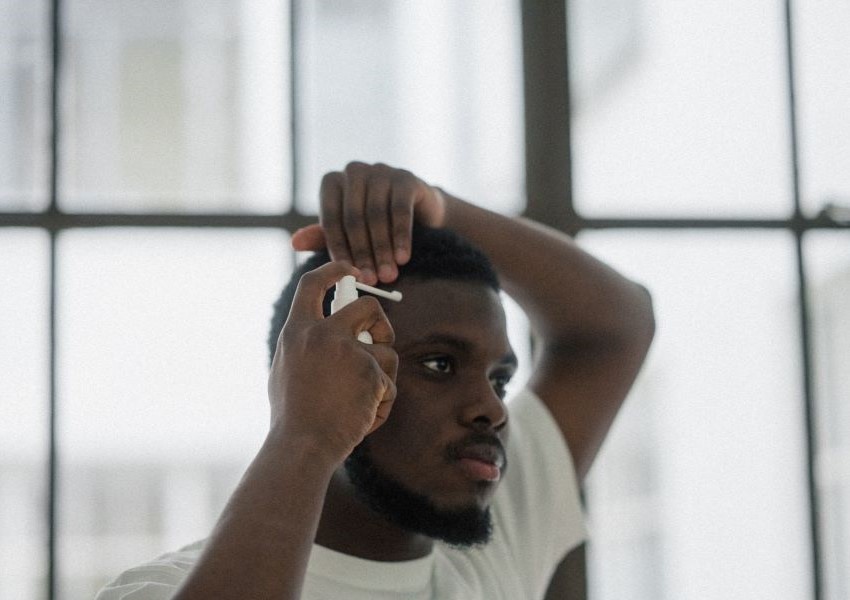

Finasteride and Minoxidil have long been the cornerstone of hair loss treatment. If you’re among the half of all men who experience hair loss by their fifties, you’ve probably heard of these treatments or even use them yourself.
The most common forms are Oral Finasteride and Topical Minoxidil. However, new formulations are entering the scene as promising alternatives which may have some advantages over their longstanding counterparts.
Here we look at some of the leading research on Oral Minoxidil and Topical Finasteride.
Finasteride is a DHT-blocker, meaning it blocks the hormone dihydrotestosterone (DHT) which is responsible for male pattern baldness. DHT builds up on the scalp and causes ‘miniaturisation’ of the hair follicles, cutting them off from the blood supply so they stop growing and eventually die. By blocking the detrimental effects of DHT, Finasteride has been clinically proven to be very effective at halting further hair loss and improving the count and quality of hair so that it grows back thicker and longer. Results usually become visible after just 3-6 months and progressively improve over time with continued, consistent use.
Topical Minoxidil is the other licensed treatment for hair loss, tried-and-tested by many over the years. While the mechanism of action is still not fully understood, it is believed to promote blood flow to the scalp, creating an optimal environment for healthy hair growth by supplying essential oxygen and nutrients to the follicles. It may also shorten the telogen (resting) phase and lengthen the anagen (growth) phase of the follicle, leading to faster growth of stronger hair.
While both treatments are effective individually, they often work best together. A study comparing 1mg Finasteride, 5% Minoxidil, and their combination found the most significant improvement in the group using both treatments. For optimal results, we recommend a combined approach.
Oral Minoxidil, usually prescribed at a 2.5 mg dose for male pattern baldness, is gaining attention as an alternative to its topical counterpart. A 2021 study comparing oral Minoxidil with topical Minoxidil over 24 weeks found comparable results in hair regrowth between the two groups.
Oral Minoxidil may be preferable for those who have experienced scalp irritation with Topical Minoxidil, or who struggle to stay consistent in applying the Minoxidil Spray twice daily. A 2023 review revealed that 86% of participants stopped using Topical Minoxidil during the study, mainly due to side effects like initial shedding, scalp irritation, and unwanted facial hair growth (hypertrichosis), or a perception that it wasn’t working.
Oral Minoxidil can help address these concerns which reduce patient compliance with the spray. As a once-daily pill, it is easier to stick to, won’t cause any local irritation, and doesn’t come with any cosmetic drawbacks like greasy hair, which some may experience with Topical Minoxidil.
While Oral Finasteride is highly effective, some men report sexual side effects such as reduced libido or erectile dysfunction. Studies suggest these effects occur in 2-4% of users and often resolve with continued use or after stopping the medication.
For those concerned about systemic side effects, Topical Finasteride may offer a safer alternative. Applied directly to the scalp, it targets the hair follicles locally rather than systemically. A 2021 study found that 0.25% Topical Finasteride was as effective as the oral 1 mg version, with similar increases in hair count over 24 weeks. Additionally, adverse events were less common in the topical group, and 96.9% of side effects were classified as mild or moderate. The study also found that Topical Finasteride reduced serum DHT by 34.6%, compared to 55.6% with Oral Finasteride – suggesting a lower risk of systemic side effects.
Another study found significantly superior improvements in hair density in patients using a Combination Spray containing 0.25% Finasteride and 3% Minoxidil, compared to 3% Minoxidil alone. 90% of participants using the Combination Spray experienced moderate to marked improvement, and none reported systemic side effects.
These emerging formulations – Oral Minoxidil and Topical Finasteride – represent exciting developments in hair loss treatment. They expand the range of options available, allowing guys to choose a regimen that aligns with their lifestyle, preferences, and tolerance for side effects.
As research continues to evolve, so does the possibility of finding the treatment that works best for you.
All of our blog articles are reviewed for medical accuracy by our Medical Director before publication.